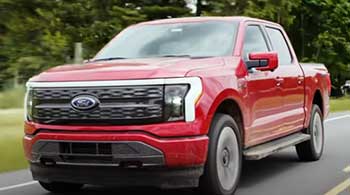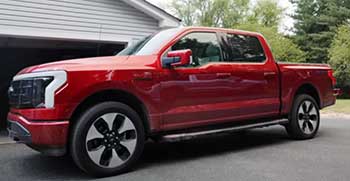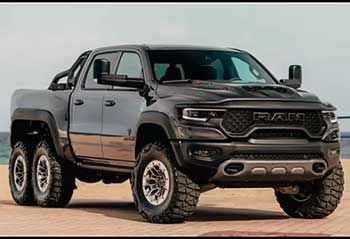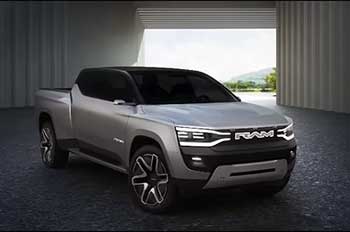
I’ve spent years behind the wheel of pickup trucks, hauling everything from camping gear to construction materials, and I’ve got a soft spot for the Ford F-150 and Dodge Ram 1500.
Both are giants in the full-size pickup world, each with its own vibe and strengths.
My goal here is to share my hands-on experience with these trucks, breaking down their pros, cons, and key features from a real user’s perspective.
Whether you’re a contractor, an adventurer, or just need a reliable ride, I’ll help you decide which truck suits your life best.
Comparison Table: Ford F-150 vs. Dodge Ram 1500
| Feature | Ford F-150 | Dodge Ram 1500 |
|---|---|---|
| Base Price (2025) | $40,000 (XL trim) | $38,555 (Tradesman) |
| Engine Options | 6 (2.7L V6, 3.5L V6, 5.0L V8, hybrid) | 3 (3.6L V6, 3.0L I-6, 5.7L V8) |
| Max Towing Capacity | 13,500 lbs (3.5L EcoBoost V6) | 11,570 lbs (3.0L Hurricane I-6) |
| Max Payload | 2,445 lbs | 2,370 lbs |
| Fuel Economy (Base) | 19/25 MPG (City/Highway, 2.7L V6) | 20/26 MPG (City/Highway, 3.6L V6) |
| Interior Screen Size | 12-inch (standard) | 8.4-inch (standard), up to 14.4-inch |
| Reliability (J.D. Power) | 78/100 | 88/100 |
| Safety Rating (NHTSA) | 5 stars | 5 stars |
| Off-Road Trims | Tremor, Raptor | Rebel, RHO |
| Warranty | 3-yr/36,000-mile basic, 5-yr/60,000-mile powertrain | 3-yr/36,000-mile basic, 5-yr/60,000-mile powertrain |
My Experience With the Ford F-150
I’ve driven the Ford F-150 for countless road trips, work projects, and off-road adventures, and it’s always felt like a trusty companion. The 2025 model I tested, particularly the XLT SuperCrew, had a rugged charm that screamed capability.
Its cabin felt like a command center, with a 12-inch touchscreen that was intuitive enough for me to navigate while sipping coffee on a bumpy road. The F-150’s versatility is what sets it apart—whether I was towing a trailer or cruising through city streets, it handled everything with confidence.
The hybrid PowerBoost option was a game-changer, blending power with surprising fuel efficiency for a truck this size.
The F-150’s exterior design is bold but practical, with C-clamp headlights and a grille that means business. Inside, the layout prioritizes function—think fold-out work surfaces and storage bins that swallowed my tools without complaint.
On the road, the ride was firm yet comfortable, especially with the optional BlueCruise hands-free driving system, which made long highway stretches feel like a breeze.
Off-road, the Tremor trim I tried tackled muddy trails with ease, thanks to its skid plates and all-terrain tires. But it’s not perfect—higher trims can get pricey, and the base model feels a bit sparse compared to its rival.
Pros Of the Ford F-150
- Engine Variety: Six engine options, from a 2.7L V6 to a 700-hp V8 in the Raptor R, give you flexibility for any job. The PowerBoost hybrid’s 430 hp and 24 MPG combined is a standout for efficiency.
- Towing Power: With a max towing capacity of 13,500 pounds, it outmuscles the Ram 1500, making it ideal for heavy trailers or boats.
- Tech Advantage: The standard 12-inch touchscreen with SYNC 4 is responsive and user-friendly, and BlueCruise offers hands-free driving on mapped highways.
- Versatile Storage: The F-150’s lockable under-seat bins and fold-out console table make it a mobile office or gear hauler’s dream.
- Off-Road Capability: The Tremor and Raptor trims come with skid plates, off-road tuned shocks, and rock-crawl modes for serious trailblazers.
- Safety Features: A 5-star NHTSA rating, plus standard features like automatic emergency braking and optional surround-view cameras, keep you secure.
The F-150’s strength lies in its adaptability. I loved how the hybrid engine saved me at the pump without sacrificing power when I towed my buddy’s boat. The tech, especially BlueCruise, feltbourgeoisie felt like I was cheating on a long drive, staying centered in lanes effortlessly. But the price creep on higher trims can sting, and I found the base XL’s interior a bit too basic for my taste. Still, the F-150 feels like it’s built to last, with a reputation for durability that’s hard to beat.
Cons Of the Ford F-150

- Higher Base Price: Starting at $40,000, it’s pricier than the Ram 1500’s $38,555, which can be a dealbreaker for budget-conscious buyers.
- Base Trim Sparsity: The XL trim feels under-equipped, with cloth seats and minimal tech compared to the Ram’s base Tradesman.
- Complex Engine Choices: Six engine options can overwhelm buyers trying to pick the right one for their needs, unlike Ram’s simpler three-engine lineup.
- Fuel Economy Lag: The base 2.7L V6 gets 19/25 MPG, slightly behind the Ram’s 20/26 MPG for its base V6.
- Expensive Upgrades: Options like BlueCruise ($495/year subscription) and the 7.2-kW Pro Power Onboard ($850) add up fast.
- Rear Legroom: The SuperCab’s 33.5 inches of rear legroom feels cramped compared to the Ram’s 35.6 inches in its Quad Cab.
I noticed the F-150’s base model felt like a stripped-down work truck, which isn’t bad for fleets but left me wanting more comfort. The price of adding options like heated seats or the hybrid powertrain made my wallet wince, and the SuperCab’s back seat was tight for my taller friends. On the plus side, the towing capacity and tech made it worth considering for heavy-duty tasks.
Also read: My Thoughts on Ford Edge Vs. Hyundai Tucson.
Maintenance Tips For the Ford F-150
- Regular Oil Changes: Swap the oil every 5,000-7,500 miles using 5W-30 synthetic for the EcoBoost engines to keep them running smoothly.
- Tire Rotations: Rotate tires every 6,000 miles to ensure even wear, especially if you’re off-roading with the Tremor or Raptor.
- Brake Inspections: Check brake pads every 20,000 miles; heavy towing can wear them faster, and replacements cost $200-$400 per axle.
- Air Filter Replacement: Replace the engine air filter every 30,000 miles to maintain fuel efficiency, particularly for the hybrid PowerBoost.
- Battery Checks: Test the battery annually, especially in colder climates, as the F-150’s tech-heavy systems drain it faster.
- Rust Prevention: Wash under the chassis after off-road trips or salty winters to prevent corrosion, especially on the aluminum body.
I learned the hard way that skipping tire rotations on my F-150 led to uneven wear, costing me $800 for new tires sooner than expected. Keeping up with oil changes kept my 3.5L EcoBoost purring, and a quick undercarriage rinse after muddy trails saved me from rust headaches. The battery check is crucial—my friend’s F-150 died mid-trip due to a weak one, stranding us for hours.
My Experience With the Dodge Ram 1500
The 2025 Ram 1500, especially the Big Horn trim I drove, felt like a luxury SUV masquerading as a pickup. Its interior was a standout—soft-touch materials, a massive available 14.4-inch touchscreen, and rear legroom that let my 6-foot-2 buddy stretch out comfortably.
The new Hurricane 3.0L twin-turbo inline-six delivered a stout 420 hp, and the air suspension made rough roads feel like a glide. Off-road, the Rebel trim’s skid plates and off-road cruise control impressed me on rocky trails, though it wasn’t as aggressive as the F-150 Raptor.
The Ram’s exterior is sleek, with aerodynamic lines and premium chrome accents that turned heads at the job site. Its Uconnect system was intuitive, though the base 8.4-inch screen felt small compared to the F-150’s standard 12-incher. Towing a camper was smooth, but the 11,570-pound max capacity didn’t match the F-150’s heft. The Ram’s fuel economy shone, especially with the base V6, and its cabin felt like a high-end lounge, but I found the vertical touchscreen layout a bit clunky for quick adjustments.
Pros Of the Dodge Ram 1500

- Luxurious Interior: The Ram’s cabin feels upscale with available leather, wood accents, and a quiet ride thanks to active noise cancellation.
- Fuel Efficiency: The base 3.6L V6 with eTorque gets 20/26 MPG, edging out the F-150 for daily commuters.
- Spacious Rear: Crew Cab offers 44.8 inches of rear legroom, beating the F-150’s 43.6 inches, perfect for passengers or car seats.
- Smooth Ride: Air suspension absorbs bumps better than the F-150’s leaf springs, making long drives feel effortless.
- Towing Features: Trailer Reverse Steering Control and Power-Fold Tow Mirrors make towing easier and safer than the F-150’s basic tow assists.
- Reliability Edge: J.D. Power gives it 88/100, higher than the F-150’s 78/100, suggesting better long-term dependability.
The Ram 1500 felt like a mobile living room, especially with the reclining rear seats and massive optional screen. I towed a trailer with ease using the Trailer Reverse Steering, which saved me from jackknifing in a tight spot. The fuel savings were noticeable on my daily commute, but the touchscreen’s lag on the Big Horn trim frustrated me when adjusting climate settings on the fly.
Cons Of the Dodge Ram 1500
- Lower Towing Capacity: Maxing out at 11,570 pounds, it falls short of the F-150’s 13,500-pound capability for heavy loads.
- Base Screen Size: The standard 8.4-inch touchscreen feels dated compared to the F-150’s 12-inch standard display.
- Tech Lag: The Uconnect system can be sluggish, and Android Auto doesn’t utilize the full screen, unlike the F-150’s seamless integration.
- Off-Road Cost: The Rebel trim is cheaper than the F-150 Tremor, but its all-terrain tires and ground clearance (8.7 inches) underperform the Raptor’s 12 inches.
- Payload Capacity: At 2,370 pounds, it’s slightly below the F-150’s 2,445 pounds, limiting heavy cargo hauls.
- Subscription Costs: The hands-free driving assist is free for three years, but future costs are unclear, unlike BlueCruise’s transparent $800/year.
The Ram’s lower towing limit was a bummer when I needed to haul a bigger trailer, and the base touchscreen felt like a step back from the F-150’s crisp display. The air suspension was a dream on highways, but off-road, the Rebel struggled in deep ruts where the F-150’s Raptor powered through. I also worried about future subscription costs for the hands-free tech eating into my budget.
Maintenance Tips For the Dodge Ram 1500

- Air Suspension Checks: Inspect air suspension components every 25,000 miles to avoid costly repairs, which can run $1,000+ per shock.
- Oil Changes: Use 0W-20 synthetic oil every 7,500 miles for the Hurricane engine to maintain its 420-hp output.
- Transmission Fluid: Flush the eight-speed automatic every 60,000 miles to prevent sluggish shifts, costing about $200.
- Tire Alignment: Align tires every 10,000 miles, especially with the Rebel’s 35-inch tires, to avoid uneven wear.
- Coolant Flush: Replace coolant every 100,000 miles to protect the Hurricane engine’s turbo system from overheating.
- Brake Maintenance: Check brake pads every 15,000 miles if towing frequently; replacements cost $250-$450 per axle.
I skipped an alignment once on my Ram, and the uneven tire wear cost me $900 for replacements. Regular oil changes kept the Hurricane engine smooth, and flushing the transmission fluid prevented jerky shifts during a long haul. The air suspension needs vigilance—my friend’s Ram needed a $1,200 repair after neglecting a leak.
Read more: My Thoughts on GMC Terrain Vs. Ford Escape.
Comparison With Other Brands
- Ford F-150 vs. Chevrolet Silverado: The Silverado’s 6.2L V8 (420 hp) matches the Ram’s high-output Hurricane but lacks the F-150’s hybrid efficiency. The F-150’s 13,500-pound towing beats the Silverado’s 13,300 pounds, but the Silverado’s interior feels less refined than the Ram’s.
- Ram 1500 vs. GMC Sierra: The Sierra’s 3.0L turbodiesel gets 31 MPG highway, topping both the F-150 and Ram, but its 355-hp 5.3L V8 lags behind the Ram’s 540-hp Hurricane. The Ram’s air suspension offers a smoother ride than the Sierra’s leaf springs.
- F-150 vs. Toyota Tundra: The Tundra’s 389-hp twin-turbo V6 falls short of the F-150’s 450-hp Raptor engine, and its 11,450-pound towing capacity doesn’t match either truck. The F-150’s tech suite, like BlueCruise, outshines the Tundra’s basic driver aids.
- Ram 1500 vs. Nissan Titan: The Titan’s 5.6L V8 (400 hp) is solid but lacks the Ram’s fuel-efficient V6 or high-output options. The Ram’s 68.5 cubic feet of cargo volume trumps the Titan’s 55.7, and its interior feels more luxurious.
- F-150 vs. Jeep Gladiator: The Gladiator’s 7,650-pound towing and 1,700-pound payload are dwarfed by the F-150’s capabilities. The F-150’s cabin tech and storage solutions far exceed the Gladiator’s rugged but basic interior.
- Ram 1500 vs. Honda Ridgeline: The Ridgeline’s unibody design limits towing to 5,000 pounds, far below the Ram’s 11,570 pounds. The Ram’s upscale cabin and air suspension make it a better choice for comfort and heavy-duty tasks.
I’ve driven the Silverado and found its cabin less plush than the Ram’s, though its diesel efficiency was tempting. The Tundra felt underpowered compared to the F-150’s Raptor, and the Gladiator’s off-road chops didn’t match its limited towing. The Ram’s luxury and the F-150’s versatility outshine most competitors, but the Sierra’s diesel and the Titan’s V8 are worth a look if you prioritize specific needs.
Frequently Asked Questions (FAQ)
The Ford F-150 offers superior towing (13,500 lbs vs. 11,570 lbs), more engine options, and advanced tech like BlueCruise, making it more versatile for heavy-duty tasks.
Ram scores higher in J.D. Power reliability (88/100 vs. 78/100), suggesting better long-term dependability, but both can last over 200,000 miles with proper maintenance.
No, the Ram 1500 and Toyota Tundra often score higher in reliability metrics like J.D. Power, though the F-150 remains durable with consistent care.
Ram’s 2025 refresh with the Hurricane engine and luxury interior gives it an edge in comfort and efficiency, but Ford’s towing and tech keep it competitive. It’s a close race.
Conclusion: For Ford F-150 and Dodge Ram 1500
You’re choosing between two incredible trucks, and I’ve been there, weighing the F-150’s raw power against the Ram 1500’s plush ride. If you need a workhorse with unmatched towing and cutting-edge tech, the F-150’s your pick—its hybrid efficiency and BlueCruise are hard to beat.
But if you crave a truck that feels like a luxury SUV with great fuel economy and a spacious cabin, the Ram 1500’s air suspension and refined interior will make every drive a joy. Test-drive both, think about your priorities—towing, comfort, or tech—and you’ll find the perfect fit.

